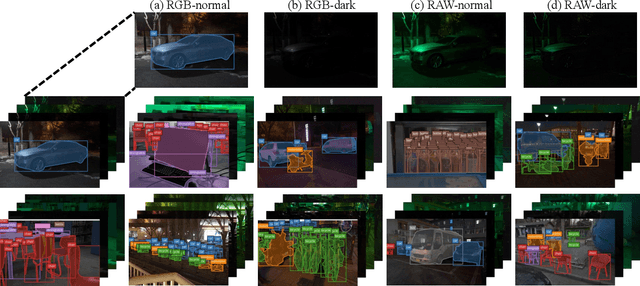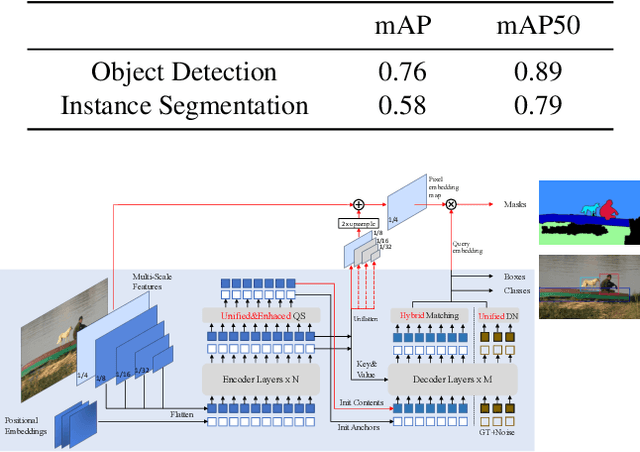Cong Li
DACA-Net: A Degradation-Aware Conditional Diffusion Network for Underwater Image Enhancement
Jul 30, 2025Abstract:Underwater images typically suffer from severe colour distortions, low visibility, and reduced structural clarity due to complex optical effects such as scattering and absorption, which greatly degrade their visual quality and limit the performance of downstream visual perception tasks. Existing enhancement methods often struggle to adaptively handle diverse degradation conditions and fail to leverage underwater-specific physical priors effectively. In this paper, we propose a degradation-aware conditional diffusion model to enhance underwater images adaptively and robustly. Given a degraded underwater image as input, we first predict its degradation level using a lightweight dual-stream convolutional network, generating a continuous degradation score as semantic guidance. Based on this score, we introduce a novel conditional diffusion-based restoration network with a Swin UNet backbone, enabling adaptive noise scheduling and hierarchical feature refinement. To incorporate underwater-specific physical priors, we further propose a degradation-guided adaptive feature fusion module and a hybrid loss function that combines perceptual consistency, histogram matching, and feature-level contrast. Comprehensive experiments on benchmark datasets demonstrate that our method effectively restores underwater images with superior colour fidelity, perceptual quality, and structural details. Compared with SOTA approaches, our framework achieves significant improvements in both quantitative metrics and qualitative visual assessments.
Toward Scalable Multirobot Control: Fast Policy Learning in Distributed MPC
Dec 27, 2024



Abstract:Distributed model predictive control (DMPC) is promising in achieving optimal cooperative control in multirobot systems (MRS). However, real-time DMPC implementation relies on numerical optimization tools to periodically calculate local control sequences online. This process is computationally demanding and lacks scalability for large-scale, nonlinear MRS. This article proposes a novel distributed learning-based predictive control (DLPC) framework for scalable multirobot control. Unlike conventional DMPC methods that calculate open-loop control sequences, our approach centers around a computationally fast and efficient distributed policy learning algorithm that generates explicit closed-loop DMPC policies for MRS without using numerical solvers. The policy learning is executed incrementally and forward in time in each prediction interval through an online distributed actor-critic implementation. The control policies are successively updated in a receding-horizon manner, enabling fast and efficient policy learning with the closed-loop stability guarantee. The learned control policies could be deployed online to MRS with varying robot scales, enhancing scalability and transferability for large-scale MRS. Furthermore, we extend our methodology to address the multirobot safe learning challenge through a force field-inspired policy learning approach. We validate our approach's effectiveness, scalability, and efficiency through extensive experiments on cooperative tasks of large-scale wheeled robots and multirotor drones. Our results demonstrate the rapid learning and deployment of DMPC policies for MRS with scales up to 10,000 units.
scReader: Prompting Large Language Models to Interpret scRNA-seq Data
Dec 24, 2024



Abstract:Large language models (LLMs) have demonstrated remarkable advancements, primarily due to their capabilities in modeling the hidden relationships within text sequences. This innovation presents a unique opportunity in the field of life sciences, where vast collections of single-cell omics data from multiple species provide a foundation for training foundational models. However, the challenge lies in the disparity of data scales across different species, hindering the development of a comprehensive model for interpreting genetic data across diverse organisms. In this study, we propose an innovative hybrid approach that integrates the general knowledge capabilities of LLMs with domain-specific representation models for single-cell omics data interpretation. We begin by focusing on genes as the fundamental unit of representation. Gene representations are initialized using functional descriptions, leveraging the strengths of mature language models such as LLaMA-2. By inputting single-cell gene-level expression data with prompts, we effectively model cellular representations based on the differential expression levels of genes across various species and cell types. In the experiments, we constructed developmental cells from humans and mice, specifically targeting cells that are challenging to annotate. We evaluated our methodology through basic tasks such as cell annotation and visualization analysis. The results demonstrate the efficacy of our approach compared to other methods using LLMs, highlighting significant improvements in accuracy and interoperability. Our hybrid approach enhances the representation of single-cell data and offers a robust framework for future research in cross-species genetic analysis.
A Unified Platform for At-Home Post-Stroke Rehabilitation Enabled by Wearable Technologies and Artificial Intelligence
Nov 28, 2024



Abstract:At-home rehabilitation for post-stroke patients presents significant challenges, as continuous, personalized care is often limited outside clinical settings. Additionally, the absence of comprehensive solutions addressing diverse rehabilitation needs in home environments complicates recovery efforts. Here, we introduce a smart home platform that integrates wearable sensors, ambient monitoring, and large language model (LLM)-powered assistance to provide seamless health monitoring and intelligent support. The system leverages machine learning enabled plantar pressure arrays for motor recovery assessment (94% classification accuracy), a wearable eye-tracking module for cognitive evaluation, and ambient sensors for precise smart home control (100% operational success, <1 s latency). Additionally, the LLM-powered agent, Auto-Care, offers real-time interventions, such as health reminders and environmental adjustments, enhancing user satisfaction by 29%. This work establishes a fully integrated platform for long-term, personalized rehabilitation, offering new possibilities for managing chronic conditions and supporting aging populations.
Wearable intelligent throat enables natural speech in stroke patients with dysarthria
Nov 28, 2024



Abstract:Wearable silent speech systems hold significant potential for restoring communication in patients with speech impairments. However, seamless, coherent speech remains elusive, and clinical efficacy is still unproven. Here, we present an AI-driven intelligent throat (IT) system that integrates throat muscle vibrations and carotid pulse signal sensors with large language model (LLM) processing to enable fluent, emotionally expressive communication. The system utilizes ultrasensitive textile strain sensors to capture high-quality signals from the neck area and supports token-level processing for real-time, continuous speech decoding, enabling seamless, delay-free communication. In tests with five stroke patients with dysarthria, IT's LLM agents intelligently corrected token errors and enriched sentence-level emotional and logical coherence, achieving low error rates (4.2% word error rate, 2.9% sentence error rate) and a 55% increase in user satisfaction. This work establishes a portable, intuitive communication platform for patients with dysarthria with the potential to be applied broadly across different neurological conditions and in multi-language support systems.
pFLFE: Cross-silo Personalized Federated Learning via Feature Enhancement on Medical Image Segmentation
Jun 29, 2024



Abstract:In medical image segmentation, personalized cross-silo federated learning (FL) is becoming popular for utilizing varied data across healthcare settings to overcome data scarcity and privacy concerns. However, existing methods often suffer from client drift, leading to inconsistent performance and delayed training. We propose a new framework, Personalized Federated Learning via Feature Enhancement (pFLFE), designed to mitigate these challenges. pFLFE consists of two main stages: feature enhancement and supervised learning. The first stage improves differentiation between foreground and background features, and the second uses these enhanced features for learning from segmentation masks. We also design an alternative training approach that requires fewer communication rounds without compromising segmentation quality, even with limited communication resources. Through experiments on three medical segmentation tasks, we demonstrate that pFLFE outperforms the state-of-the-art methods.
MH-pFLGB: Model Heterogeneous personalized Federated Learning via Global Bypass for Medical Image Analysis
Jun 29, 2024Abstract:In the evolving application of medical artificial intelligence, federated learning is notable for its ability to protect training data privacy. Federated learning facilitates collaborative model development without the need to share local data from healthcare institutions. Yet, the statistical and system heterogeneity among these institutions poses substantial challenges, which affects the effectiveness of federated learning and hampers the exchange of information between clients. To address these issues, we introduce a novel approach, MH-pFLGB, which employs a global bypass strategy to mitigate the reliance on public datasets and navigate the complexities of non-IID data distributions. Our method enhances traditional federated learning by integrating a global bypass model, which would share the information among the clients, but also serves as part of the network to enhance the performance on each client. Additionally, MH-pFLGB provides a feature fusion module to better combine the local and global features. We validate \model{}'s effectiveness and adaptability through extensive testing on different medical tasks, demonstrating superior performance compared to existing state-of-the-art methods.
Technique Report of CVPR 2024 PBDL Challenges
Jun 15, 2024



Abstract:The intersection of physics-based vision and deep learning presents an exciting frontier for advancing computer vision technologies. By leveraging the principles of physics to inform and enhance deep learning models, we can develop more robust and accurate vision systems. Physics-based vision aims to invert the processes to recover scene properties such as shape, reflectance, light distribution, and medium properties from images. In recent years, deep learning has shown promising improvements for various vision tasks, and when combined with physics-based vision, these approaches can enhance the robustness and accuracy of vision systems. This technical report summarizes the outcomes of the Physics-Based Vision Meets Deep Learning (PBDL) 2024 challenge, held in CVPR 2024 workshop. The challenge consisted of eight tracks, focusing on Low-Light Enhancement and Detection as well as High Dynamic Range (HDR) Imaging. This report details the objectives, methodologies, and results of each track, highlighting the top-performing solutions and their innovative approaches.
Self-reconfigurable Multifunctional Memristive Nociceptor for Intelligent Robotics
Jun 13, 2024Abstract:Artificial nociceptors, mimicking human-like stimuli perception, are of significance for intelligent robotics to work in hazardous and dynamic scenarios. One of the most essential characteristics of the human nociceptor is its self-adjustable attribute, which indicates that the threshold of determination of a potentially hazardous stimulus relies on environmental knowledge. This critical attribute has been currently omitted, but it is highly desired for artificial nociceptors. Inspired by these shortcomings, this article presents, for the first time, a Self-Directed Channel (SDC) memristor-based self-reconfigurable nociceptor, capable of perceiving hazardous pressure stimuli under different temperatures and demonstrates key features of tactile nociceptors, including 'threshold,' 'no-adaptation,' and 'sensitization.' The maximum amplification of hazardous external stimuli is 1000%, and its response characteristics dynamically adapt to current temperature conditions by automatically altering the generated modulation schemes for the memristor. The maximum difference ratio of the response of memristors at different temperatures is 500%, and this adaptability closely mimics the functions of biological tactile nociceptors, resulting in accurate danger perception in various conditions. Beyond temperature adaptation, this memristor-based nociceptor has the potential to integrate different sensory modalities by applying various sensors, thereby achieving human-like perception capabilities in real-world environments.
Real-Time State Modulation and Acquisition Circuit in Neuromorphic Memristive Systems
Jun 01, 2024Abstract:Memristive neuromorphic systems are designed to emulate human perception and cognition, where the memristor states represent essential historical information to perform both low-level and high-level tasks. However, current systems face challenges with the separation of state modulation and acquisition, leading to undesired time delays that impact real-time performance. To overcome this issue, we introduce a dual-function circuit that concurrently modulates and acquires memristor state information. This is achieved through two key features: 1) a feedback operational amplifier (op-amp) based circuit that ensures precise voltage application on the memristor while converting the passing current into a voltage signal; 2) a division calculation circuit that acquires state information from the modulation voltage and the converted voltage, improving stability by leveraging the intrinsic threshold characteristics of memristors. This circuit has been evaluated in a memristor-based nociceptor and a memristor crossbar, demonstrating exceptional performance. For instance, it achieves mean absolute acquisition errors below 1 {\Omega} during the modulation process in the nociceptor application. These results demonstrate that the proposed circuit can operate at different scales, holding the potential to enhance a wide range of neuromorphic applications.
 Add to Chrome
Add to Chrome Add to Firefox
Add to Firefox Add to Edge
Add to Edge